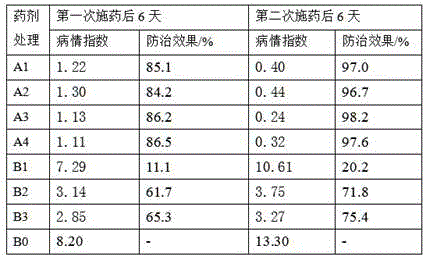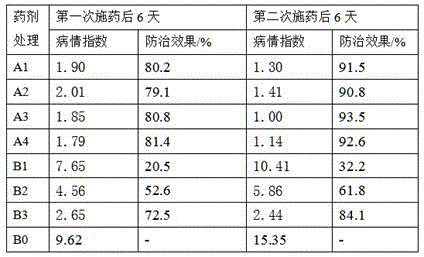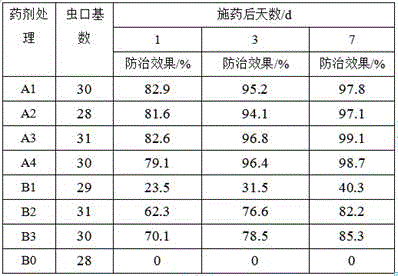Compound pesticide applied to vegetable cultivation and preparation method thereof
A technology of compounding pesticides and vegetables, applied in the field of pesticides, can solve problems such as insufficient effects of preventing and controlling pests and diseases, and achieve the effects of reducing hidden dangers of diseases, enhancing disease resistance, and good quality
- Summary
- Abstract
- Description
- Claims
- Application Information
AI Technical Summary
Problems solved by technology
Method used
Image
Examples
Embodiment 1
[0027] Embodiment 1: A kind of compound pesticide that is used for vegetable planting, is prepared by the raw material of following parts by weight: 16 parts of peanut shells, 20 parts of spent mushroom sticks, 23 parts of poultry feces, 10 parts of turmeric bark, 7 parts of mugwort part, 2 parts of jasmonic acid, 2 parts of calcium chloride, 3 parts of diatomaceous earth, 5 parts of insecticides, and described insecticides are made of the raw material of following weight parts: 1 part of dihydro-axerinin, 25 parts of Torreya chinensis 18 parts of purple amaranth, 10 parts of buttercup, 10 parts of pomegranate skin, 10 parts of white bark, 10 parts of eel vine, 7 parts of wild tobacco leaves, 8 parts of veratrum, 8 parts of leaking reed, and 5 parts of verbena.
[0028]In the present invention, poultry manure is solid waste produced by poultry breeding, including chicken manure, duck manure, etc., which contains rich organic matter and nutrients such as nitrogen, phosphorus, an...
Embodiment 2
[0042] Embodiment 2: A kind of compound pesticide for vegetable planting, is prepared by the raw material of following weight parts: 15 parts of peanut shells, 15 parts of spent mushroom sticks, 20 parts of poultry feces, 8 parts of turmeric bark, 6 parts of mugwort part, 2 parts of jasmonic acid, 1 part of calcium chloride, 2 parts of diatomaceous earth, 3 parts of insecticides, and described insecticides are made of the raw material of following weight parts: 0.5 part of dihydro-axerinin, 25 parts of Torreya japonica 15 parts of purple amaranth, 12 parts of buttercup, 8 parts of pomegranate skin, 12 parts of white bark, 12 parts of eel vine, 8 parts of wild tobacco leaves, 6 parts of veratrum, 6 parts of leaking reed, and 4 parts of verbena.
[0043] The preparation method of the compound pesticide that this embodiment is used for vegetable planting comprises the following steps:
[0044] 1) Weigh the dried peanut shells, waste mushroom sticks, sage bark and mugwort in the a...
Embodiment 3
[0054] Embodiment 3: A kind of compound pesticide for vegetable planting, is prepared by the raw material of following parts by weight: 18 parts of peanut shells, 18 parts of spent mushroom sticks, 25 parts of poultry excrement, 12 parts of turmeric bark, 8 parts of mugwort part, 3 parts of jasmonic acid, 3 parts of calcium chloride, 2 parts of diatomaceous earth, 6 parts of insecticides, and described insecticides are made of the raw material of following weight parts: 1.5 parts of dihydro-axerinin, 20 parts of Torreya chinensis 20 parts of purple amaranth, 8 parts of buttercup, 12 parts of pomegranate skin, 8 parts of white bark, 8 parts of eel vine, 6 parts of wild tobacco leaves, 7 parts of veratrum, 7 parts of drained reed, and 6 parts of verbena.
[0055] The preparation method of the compound pesticide that this embodiment is used for vegetable planting comprises the following steps:
[0056] 1) Weigh the dried peanut shells, waste mushroom sticks, sage bark and mugwort...
PUM
 Login to View More
Login to View More Abstract
Description
Claims
Application Information
 Login to View More
Login to View More - R&D
- Intellectual Property
- Life Sciences
- Materials
- Tech Scout
- Unparalleled Data Quality
- Higher Quality Content
- 60% Fewer Hallucinations
Browse by: Latest US Patents, China's latest patents, Technical Efficacy Thesaurus, Application Domain, Technology Topic, Popular Technical Reports.
© 2025 PatSnap. All rights reserved.Legal|Privacy policy|Modern Slavery Act Transparency Statement|Sitemap|About US| Contact US: help@patsnap.com



